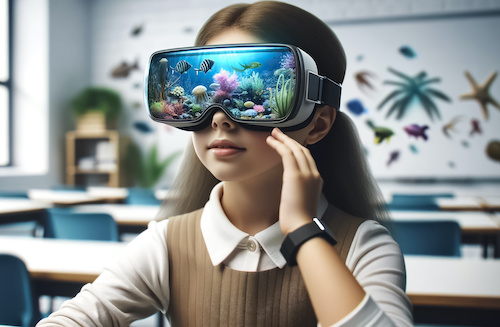Key points:
- Virtual field trips have staying power and help engage students
- Taking the classroom into the world with VR and AR
- 5 immersive learning tools for the classroom
- For more news on virtual field trips, visit eSN’s Digital Learning hub
While virtual field trips are not a new phenomenon, they gained popularity shortly before COVID due in part to their ability to expose students to places and experiences they may not otherwise access due to funding barriers or geographical limitations.
When COVID mandated at-home and hybrid learning, many educators turned once again to virtual trips to keep students engaged in learning during pandemic-related instructional challenges.
Virtual field trips
In a nutshell, virtual field trips are digital experiences and explorations through places such as landmarks, museums, or even outer space. They employ animations, images, videos, sound clips, and 3D technologies to give students an authentic-as-possible opportunity to explore pyramids, underwater ecosystems, the Grand Canyon, well-known landmarks, and more. Some virtual trips for kids are accessible with a simple device, while others employ virtual reality headsets for a more immersive experience.
Virtual field trips and STEM learning
Hands-on STEM subjects are challenging to teach when students aren’t in the classroom all the time, and student engagement remains a challenge even after COVID. Virtual field trips address both of these persistent roadblocks. These trips can help students get a front-row look at STEM outside of the classroom. Where can those engineering concepts you learn during school take you in adulthood? Is it possible to be creative in a STEM career? Here’s how to boost STEM learning with virtual field trips for students.
Bringing real-world issues into the classroom with virtual trips
Climate change is an increasingly important subject in school curriculums. Today’s students will almost certainly inherit a climate-affected world and will need to understand the mechanisms of global warming if they are to grow into climate-conscious, civic-minded members of society. However, many students are dissuaded from pursuing environmental science due to mundane textbooks and complex diagrams. This is a serious issue, as students will need an in-depth understanding of greenhouse gases and ecological damage in the future. Educators can engage students and build excitement around environmental science using the latest virtual reality (VR) technology. This tech can take students on free interactive virtual field trips, meaning they can virtually visit climate-affected areas from the safety and comfort of the classroom. Make real-world issues more relevant for students.
Virtual field trips through augmented reality
Augmented reality gives educators the opportunity to bring the world to life. But first we need to see the world. For example, educators might enrich students’ learning by taking field trips to the heart of their capital city and asking students to draw landmarks, interview tourists, use iPad voice recorders, and make films using the camera on iPad, editing them in iMovie to bring those landmarks to life. Then, using augmented reality apps, educators can link the children’s artwork to their videos and embed it all in a Google Map. This means that anyone can point their camera at the trigger image and find out more about the landmark they are visiting that day–all narrated by students. Here’s how to do it.
Why virtual field trips work
This upcoming generation of students grew up with internet-connected smart devices. For them, information comes instantaneously. Unfortunately, a barrage of apps are constantly combating their attention economy and impacting their focus and retention in class. Interactive virtual trips for elementary students can really help boost engagement. Virtual field trips with technologies such as AR and VR provide new learning opportunities that can keep students engaged and make lessons stick.
- New group targets AI skills in education and the workforce - May 6, 2024
- Friday 5: Teacher stress - May 3, 2024
- Student success is impacted by issues outside of school, survey finds - May 1, 2024

